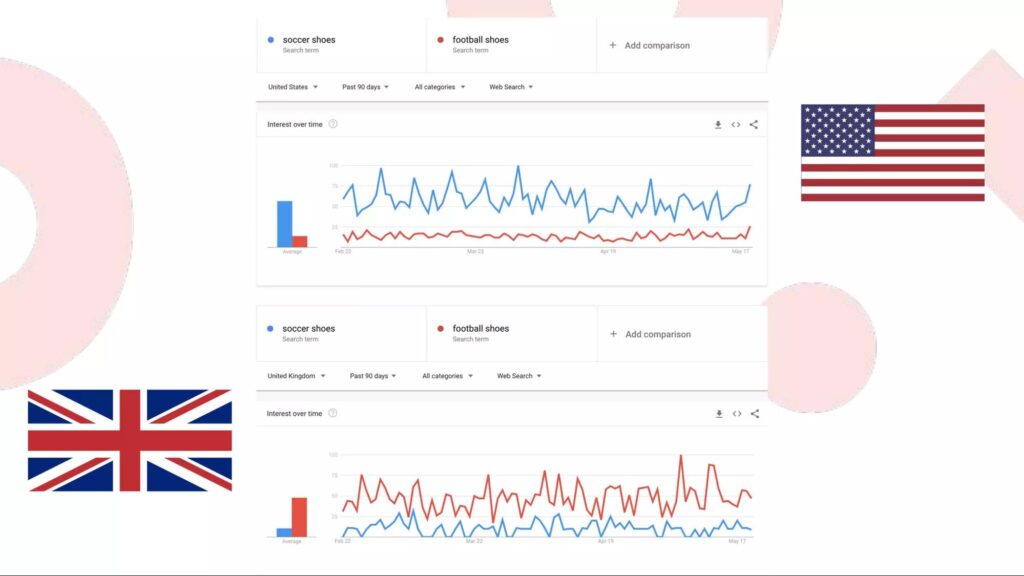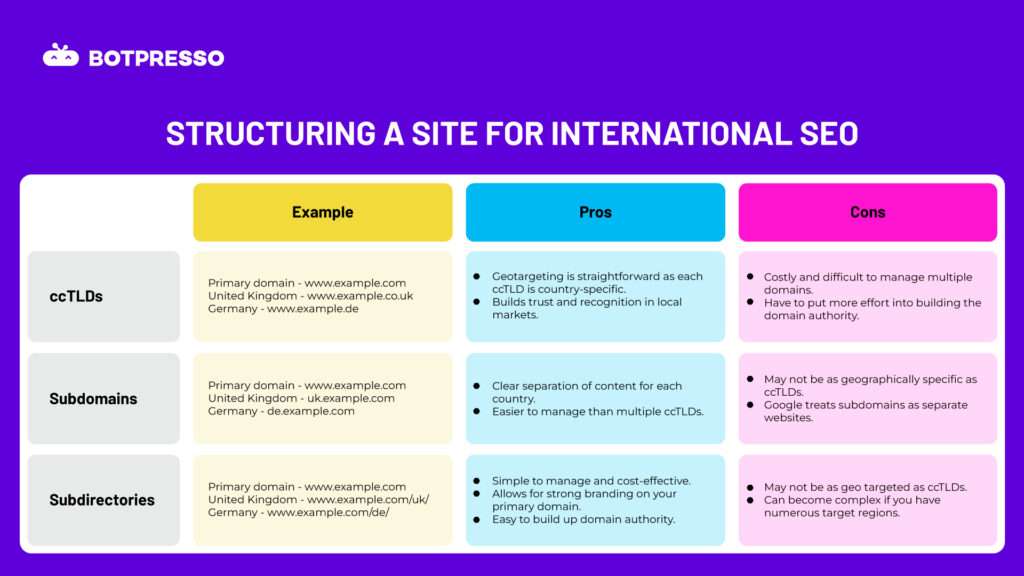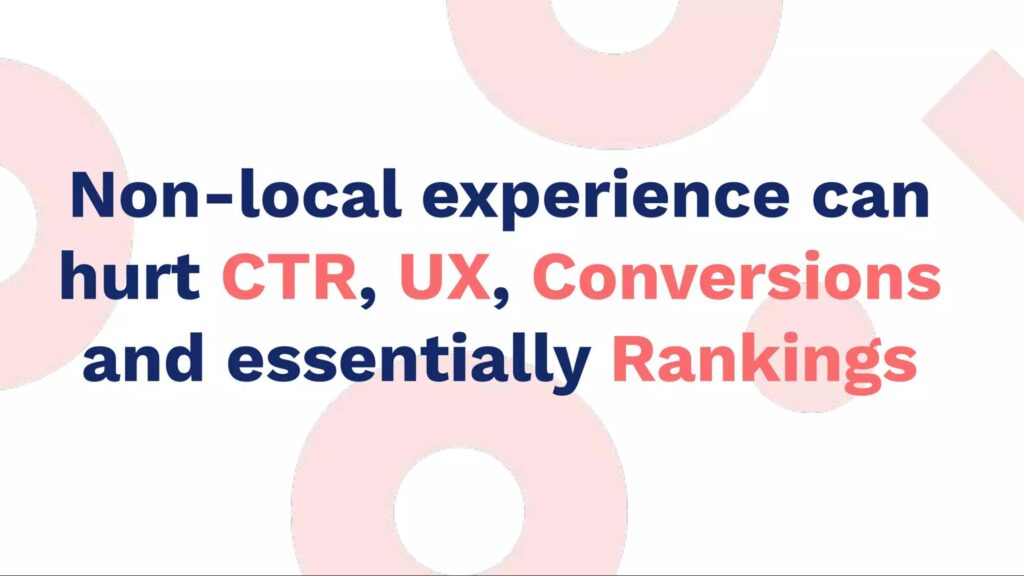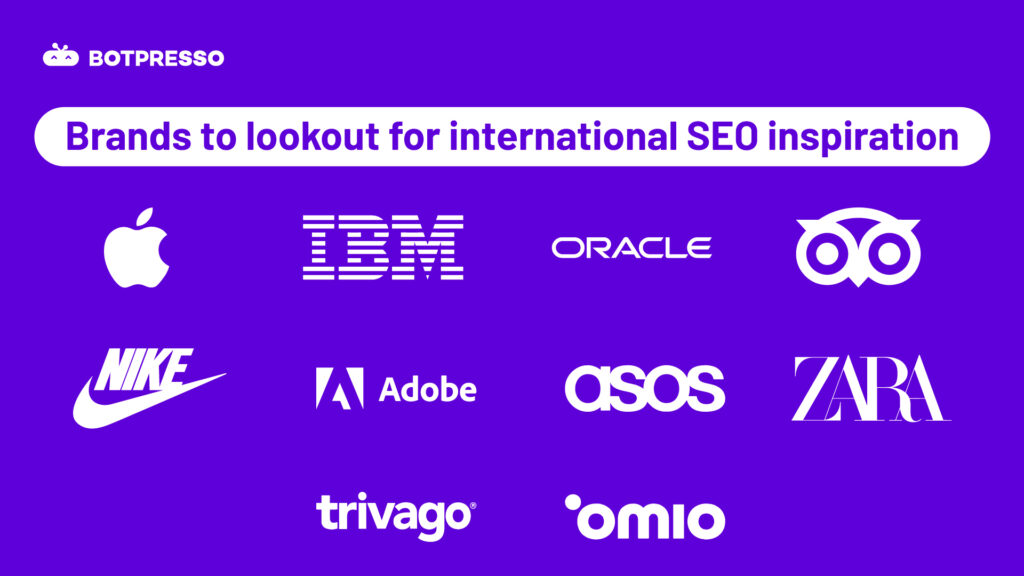Imagine you’re a movie buff (like me😜) eagerly waiting for the latest blockbuster. You’ve heard fantastic reviews about this film, and the anticipation is palpable. However, there’s a catch – it’s a foreign film, and you don’t speak the language.
International SEO is a bit like this scenario. It’s the way to take your website to a global audience, just as you’d wish for subtitles in your favourite foreign movie. In our interconnected world, businesses aren’t confined by borders anymore. 32% of IT leaders say that their organisation plans to expand in the next year. The internet has become a vast, multilingual stage.
But worry not; we’re here to demystify the magic of international SEO, making it as accessible as your favourite film with subtitles. So, grab some popcorn 🍿 and let’s embark on an exciting journey where your website can be the star of the global show.
Table of Contents
Need to go global 🌏
Think of international SEO as the key to expanding your business’s horizons. Just like a traveller needs a map to explore new places, your business needs international SEO to find its way into global markets.
- Global expansion: International SEO helps businesses reach a worldwide audience, expanding their customer base beyond local boundaries.
- Increased sales: By optimizing for different languages and countries, you can attract more visitors to your website, potentially leading to higher conversions and sales.
- Competitive advantage: Many businesses are already targeting international markets, so having a solid international SEO strategy can give you a competitive edge.
- Better user experience: Tailoring your website content to different cultures and languages can improve the user experience, making it more likely for visitors to engage with it.
- Brand credibility: Expanding globally and appearing in local search results can enhance your brand’s credibility and trustworthiness.
In a nutshell, international SEO is crucial for businesses looking to tap into the vast potential of global markets and establish a strong online presence.
Difference between international and national SEO
| Aspect | International SEO | National SEO |
|---|---|---|
| Audience | Aims to reach a global, diverse audience. | Targets a specific nation, typically the company’s origin country. |
| Location | Geared towards multiple regions and countries. | Concentrated on a specific country. |
| Culture | Requires cultural and language adaptation. | Focuses on local national culture and language. |
| Content strategy | Diverse & localised content to cater to global interests. | Tailored to suit the country’s primary language. And then can be expanded to other regional languages. |
| Competition | Can be highly competitive on a global scale. | Competition is typically less intense. |
| Project management | Involves tracking and managing multiple web properties of various regions | Easy to manage and often requires less processes. |
| Suitability | Suitable for large scale businesses having demand to go global. | Suitable for businesses serving a single country. |
International SEO strategy: Best practices to follow
Implementing international SEO strategy requires a set of best practices that can help you not only reach a global audience but also help search engines understand which country/language you are targeting. Here are some essential steps to consider:
1. Assess the demand & search behaviour
Before creating a plan to go global with your products and services, sit back and analyse the market you are trying to penetrate. Understand the market demand for your products or services and search behaviour of the target audience.
Find the Total Addressable Market for your business to understand the demand. To do that, find all the relevant keywords for your products/services and get their search volume.
"I would highly recommend understanding the market and the potential demand before you think about stepping in any different market where you are not present at the moment. So there are many tools which can help you here for example, you can check Google analytics to see from which geographies you are already receiving traffic. So that gives you a good hint about the markets where you have demand for your product."
Nitin Manchanda, International SEO And Founder of Botpresso.
2. Analyse your market competitors
Study what your competitors are doing right and wrong in your international target markets. It will help you identify opportunities and gaps in the market.
You might face different competitors across regions, so use them as your benchmark to understand what worked for them. Look at their content strategy, technical implementations to target that specific market, link profile, social influence, keyword profile, etc.
3. Do complete keyword research
Keyword research doesn’t stop at your native language. To be effective in international SEO, you’ll need to identify all the relevant keywords in each target language and region. Tools like Semrush and Ahrefs can be invaluable for this.
One crucial aspect to consider is the diversity in language and local slang. In some cases, different words may have the same meaning across various countries or regions, like “taxi” and “cab.”
This is where understanding the intricacies of local language becomes essential. It’s not enough to translate your primary keywords; you must also identify regional variations that are commonly used.
“If you’re present in two English speaking countries, let’s say Australia and the UK, so in both the countries the English varies a bit, right? I mean you have your local slang or idioms that you use there, and that’s not common in both the countries. So, you should definitely focus on local language experience to make sure that you are touching the heart of your local users.
Here’s an example: Let’s say you are selling football shoes in two countries - America and the UK. People in the US call them 'soccer shoes' and people in the UK use the term 'football shoes.' You have to optimize the two versions based on the local language to provide the localized experience.”
Nitin Manchanda, International SEO And Founder of Botpresso.

4. Choose the best website structure
The structure of your website is like the foundation of a house. Make sure you select the best structure for international SEO. Options include country code top-level domains (ccTLDs), subdomains, or subdirectories. Each has its advantages and disadvantages.

ccTLDs
Example: Your main website could be www.example.com, and for the United Kingdom, you’d use www.example.co.uk, while for Germany, it’d be www.example.de.
Pros:
- Geotargeting is straightforward as each ccTLD is country-specific.
- Builds trust and recognition in local markets.
Cons
- Costly and difficult to manage multiple domains.
- Have to put more effort into building the domain authority.
Subdomains
Example: You have your primary domain as www.example.com, and you create subdomains like uk.example.com, de.example.com, etc., for different countries.
Pros
- Clear separation of content for each country.
- Easier to manage than multiple ccTLDs.
Cons
- May not be as geographically specific as ccTLDs.
- Google treats subdomains as separate websites.
Subdirectories
Example: You maintain a single domain (www.example.com) and create subdirectories like www.example.com/uk/ or www.example.com/de/ for different countries.
Pros
- Simple to manage and cost-effective.
- Allows for strong branding on your primary domain.
- Easy to build up domain authority.
Cons
- May not be as geo targeted as ccTLDs.
- Can become complex if you have numerous target regions.

💡Note: Google strongly recommends not to use parameterized URLs for geo/language targeting. It is also not easy to segment and manage.

You can also use language targeting if that’s something you are interested in. For example, you can use example.com/es/ or es.example.com to target Spanish speaking audiences.
5. Work on localization

Localization is more than just translating your content into different languages. It’s about adapting your content to the culture and preferences of your target audience. This includes language, currency, address, phone number, units of measurement, content layout, and any cultural nuances.
If you are an ecommerce business, then visual content should also resonate with the local audience. Images and graphics should include people, scenes, and contexts that the local audience can relate to.
Here’s the Apple India website, decorated to match the festive season in India offering seasonal discounts and content related to Indian customers.

And here’s their Canadian website, without any seasonal offers, which proves localization is beyond content.

And here’s IBM differentiating what they want to emphasise between different markets.
In India:
In Canada:

6. Tidy up your internal links
Internal links help search engines understand the structure of your website. Ensure your internal linking is clear and logical for users and search engine bots.
If you are linking to US products on an India website, then you are confusing search engines with mixed signals and users with irrelevant products. So make sure your internal links are proper and are easy to navigate.
7. Set up the tags to guide bots to correct version
Hreflang tags are your best friend in international SEO. They inform search engines about the language and geographic targeting of your content, ensuring users are directed to the right version.
<link rel=”alternate” hreflang=”en-us” href=”https://www.example.com/en-us/” />
You can implement hreflang tags via:- HTML <head>
- Sitemap
- HTTP headers
You can choose whatever the implementation methods mentioned above. You can also combine any of them to specify the hreflang tags. You can also specify ‘x-default’ hreflang tag to specify a fallback page when the user’s language/geography doesn’t match with the targeting options you have.
<link rel=”alternate” href=”https://example.com/” hreflang=”x-default” />
Also, you can use the ‘meta content language’ tag to specify the language and country the page is most suitable for by placing the tag in the <head> section.
<html lang=”de”> … </html>
8. Set up the sitemaps
XML sitemaps are essential for international websites. They help search engines discover and index your content. Make sure you have separate sitemaps for each language or region.
💡Pro-tip: Generate sitemap with hreflang tags using this tool for free.
9. Create separate GSC properties
Setup individual GSC properties for each geography to understand and measure the performance of your international SEO implementation. This will also help you find and fix issues pertaining to individual properties.
10. Build contextual backlinks
Building high-quality backlinks is as vital in international SEO as in any other SEO projects. Focus on acquiring contextual backlinks from relevant, authoritative websites in your target markets.
“Backlinks do not only add authority to your brand, but it also brings some referral traffic for you, don’t forget that”
Nitin Manchanda
International SEO mistakes to avoid
- Not following the target market’s laws and regulations.
- Maintaining other markets’ products.
- Just translating content without providing any value to the users.
- Missing out hreflang return links. If page X is linking to page Y, but page Y is not linked to page X, then the hreflang annotation will be ignored.
- Incorrect language and country code. Make sure you follow ISO 639-1 format for language and ISO 3166-1 Alpha 2 format for country.
- Page X targeting the English language not linking to itself in hreflang.
- Automatically redirecting users from one language of a site to a different language based on their IP without keeping Googlebot whitelisting in place.

Google’s John Mueller in Google Webmaster Central office-hours hangout:
“Googlebot crawls from the US. So when we crawl from the US, we might still want to see the French version, or the German version, or the Italian version of a site. So we would want to be able to crawl and render these pages, see the warning (Banners for recommending different site versions) if you want to display that to us. That's perfectly fine. But still access the rest of the content on the site.
It's important that we can still use all of the internal navigation, that we can still see the content as you have it localized for those individual countries so that we can actually index the Italian content, and the French content, and the German content, and all of that.”
Our learnings from doing multiple international SEO projects
1. Never go live in a hurry: Test if all the international SEO targeting is in place and you verified the implementations in staging sites.
2. Missing out on page speed: Page loading speed is an important factor that helps improve user experience. Try hosting your international domains closer to the customers’ location. 3. Do not include
4. Unique meta title, description, & H1: Make sure geographical variations of pages have unique meta title, description, and H1 content.
5. Have an indexation strategy in place beforehand. Your go-to tool would be Google Indexing API which you need to use for high traffic pages for faster indexing.
6. Internal linking is an important factor in international SEO migrations. Even if the old stack had a poorer internal linking in place. The goal should be to improve it in the stage instance which would eventually be migrated.
Brands with successful international SEO implementation

International SEO checklist to download
Thanks for staying this far! We hope you learned something useful and on your way to implement the things learned on your next international SEO project. We know that our human brain can hold thoughts for only some time, so we have prepared a checklist that can help recollect what we saw in this article and a few other resources that can help you implement the international SEO strategy in the future.
💡You can also download the entire article in a PDF format from here.
Our answers to your questions!
1. Is there a difference between using ccTLD & subfolder?
The choice between ccTLDs and subfolders depends on your specific goals, resources, and preferences. If you want precise geotargeting and have the resources to manage multiple domains, ccTLDs may be suitable. On the other hand, if you prefer centralised management and brand consistency, subfolders can be a cost-effective and practical choice. It’s essential to align your decision with your international SEO strategy and long-term business objectives.
2. Should I just translate the content for international SEO?
No. Just translating the content from your language to other languages might be correct in terms of meaning and localization. In some cases, it might go wrong and it would paint a wrong picture about your brand. Always make sure you have someone who knows a language to write and proofread.
Reviewed & edited by: Kunjal Chawhan, SEO Manager, Botpresso.






